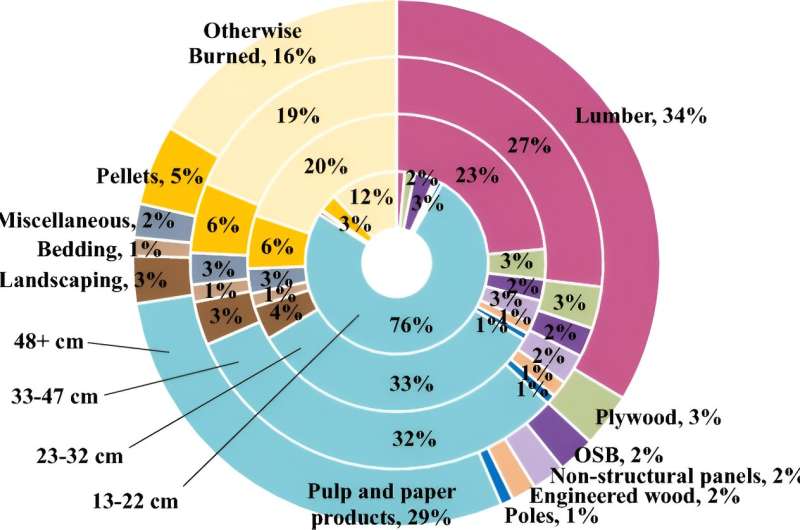This article has been reviewed according to Science X's editorial process and policies. Editors have highlighted the following attributes while ensuring the content's credibility:
fact-checked
trusted source
proofread
Improving wood products could be a key to reducing greenhouse gas emissions, researchers suggest

Harnessing the ability of wood products to store carbon even after harvest could have a significant effect on greenhouse gas emissions and change commonly accepted forestry practices, a new study from NC State researchers suggests.
A new study published in the journal Carbon Balance and Management uses carbon storage modeling to link the carbon stored in wood products with the specific forest system from which the products originated. Wood products and the forests they come from store different amounts of carbon, and being able to compare the two more specifically would help forest managers better understand these tradeoffs and plan for better carbon storage.
By tracing carbon in southern loblolly pine plantations from planting to harvest, the study also identified specific wood products that are important to improving carbon storage and reducing greenhouse gas emissions. Chief among them were corrugated cardboard boxes.
"Corrugated cardboard boxes are one of the most important products made from loblolly pine," said Sarah Puls, NC State graduate assistant and corresponding author of the study. "If we can extend the effective lifetime of products like these boxes, it could have a significant impact on the carbon storage associated with southern loblolly pine plantations."
According to the Environmental Protection Agency, these boxes make up 11.4% of all municipal solid waste and account for more than a quarter of all carbon in harvested loblolly and shortleaf pine timber.
The study found that improving the lifespan of these boxes and lowering emissions from their production and decay would lead to significant carbon gains from loblolly plantations. Although these boxes already have estimated recycling rates between 91 and 96%, increased recycling could still have a significant impact on carbon storage, the researchers say.
The study also found that smaller sawtimber logs and engineered materials like oriented strand board—a type of board made by pressing together small wooden chips—might also be good at storing carbon since they can be grown quickly but still go into long-lasting products like houses.
"Wood is a great material to use in our lives—it's renewable, it's very flexible in terms of what we can do with it, and it takes a relatively low amount of fossil fuels to produce," Puls said. "If we can find ways to keep producing wood while also improving carbon storage—that would be fantastic."
The study also found that short rotations—harvesting and replanting trees more quickly—could potentially outperform slower long rotations in carbon storage when a forest is highly productive. This finding applied specifically to pulp harvests, which produce the types of wood used in creating corrugated cardboard boxes.
Most other research in the field has found that sawtimber harvests outperform pulp in carbon storage. Sawtimber refers to trees that produce the types of straight, thick logs used in construction and furniture. Puls said that even one instance of short rotation pulp harvests outperforming sawtimber was noteworthy.
"Almost everything in the existing body of research says the opposite, that a long rotation strategy is the best for carbon storage," Puls said. "This implies that we should maybe look at plantations on a more case-by-case basis, and adjust our rotations based on specific site productivity."
Puls said that the study may help to direct future research around sustainable forestry.
"The bottom line is that we need to take climate action now. This study offers the opportunity for further research, with some specific pointers and suggestions for where we could focus," she said. "It's exciting that people are starting to understand that we need to do a better job modeling this, because we need to find ways to better use our forest resources in order to reduce emissions."
More information: Sarah J. Puls et al, Modeling wood product carbon flows in southern us pine plantations: implications for carbon storage, Carbon Balance and Management (2024). DOI: 10.1186/s13021-024-00254-4
Provided by North Carolina State University




















